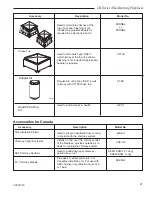
11
CR Series Woodburning Fireplaces
20001316
Hole sizes listed in Figure 10 for angled firestop spac-
ers provide minimum required air space to chimney
pipe for ceiling thickness up to 8” (203mm). When
combined thickness of ceiling material, ceiling joists
and flooring material exceeds 8” (203mm), adjustments
must be made in framing to assure that minimum air
spaces to chimney are maintained.
Proper Firestop Spacer Installation
Page 10, Figure 15 shows different installation proce-
dures for both an area that
is
an attic and an area that
is not
an attic.
If the area above the ceiling
is not
an attic, position the
firestop spacer with the flange on the ceiling side and
the angled portion extending up into the hole.
If the area above the ceiling
is
an attic, position the
firestop spacer with the flange on the top of the framed
hole and the angled portion extending down into the
hole.
Firestop spacers are not available for, nor are they
required on vertical walls.
DO NOT
put any sealant around the area where the
outer pipe slides through the firestop spacer. If you seal
this area,
it may cause a fire hazard.
Canadian Requirements for
Insulation Shield
In Canada, an attic insulation shield is required to
prevent attic insulation from contacting the chimney
section.
NOTE:
If the attic insulation shield is used, the
firestop is not required in the attic installation. Framing
dimensions for the chimney hole should measure 14
¹⁄₂
"
x 14
¹⁄₂
" (368 x 368mm) (SK8). An attic shield MUST
be installed on top of attic joists (above the floor level).
(Fig. 16)
NOTE:
In the U.S., it is a good idea, although not al-
ways required, to install an attic insulation shield where
blown-in insulation is planned to be used in the attic.
Install the attic insulation shield with the flanges on its
base extending down into the framing hole. Nail each
corner of attic insulation shield to the framing members
of the ceiling hole using 8d nails. Attic shields are not
required at the roof.
Continue Installing Pipe to Complete Run
Continue attaching pipe sections to complete system
to next level always being careful the pipe is firmly
snapped locked in place before proceeding to next pipe
section.
Chimney Supports
If chimney supports are required, they are installed
the same as elbows. Nail chimney support straps to
adjacent structural framing, as shown on Page 7, Figure
6. Bend straps as necessary and make sure they are
secure so they will support the weight of the chimney.
A chimney support is 2
¹⁄₂
" (64mm) long when installed.
Consider this dimension when determining how many
straight chimney sections are needed.
Note:
Chimney supports are generally used in long
runs in a chase installation.
A chimney support can-
not be mounted directly to the fireplace.
Additional Ceilings
If you encounter additional ceilings, repeat same steps
required for first ceiling installation. Refer to firestop
illustration on Page 10, Figure 15.
Penetrating the Roof
Run pipe to roofline. Since chimney system must be
vented to the out-of-doors, you
must
use an approved
termination.
If a chase is used, refer to the installation manual pro-
vided with the termination cap.
Locate Chimney Centerpoint On Roof
Use same procedure detailed in locating center point of
the flue system.
Drive a nail up through roof at the center point. This will
determine center point on outside of the roof.
FP263
Fig. 16
Attic shield installlation (Canadian requirement).
FP263
Install Attic Insul Shield
5/9/96
Attic
Insulation
Shield
Ceiling
Nails
(4 Required)
Attic Joist
Base Flanges










































